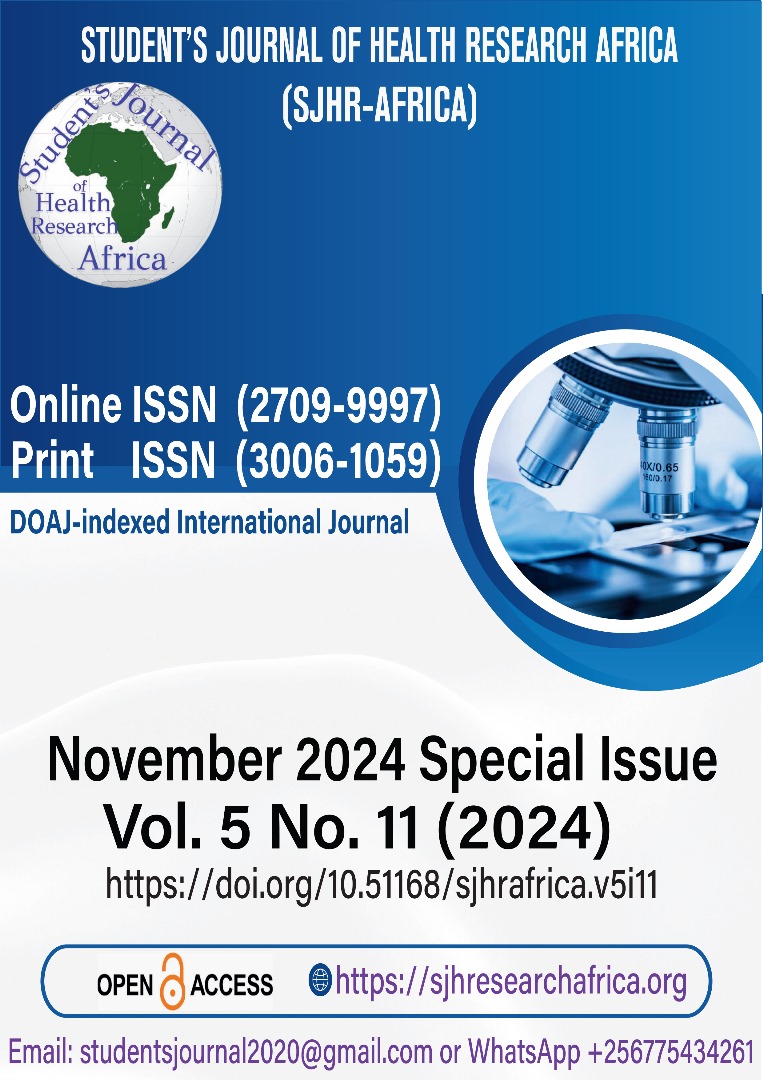Comparison of the effect of epidural levobupivacaine 0.5% 20 ml and ropivacaine 0.75%, 20 ml in lower limb surgeries
DOI:
https://doi.org/10.51168/sjhrafrica.v5i11.1813Keywords:
Epidural anaesthesia, levobupivacaine, ropivacaine, lower limb surgery, sensory block, motor block, postoperative analgesiaAbstract
Background
Epidural anesthesia is extensively employed in lower limb procedures owing to its efficacy in sensory and motor blockage, as well as its capacity to deliver extended postoperative analgesia. Levobupivacaine and ropivacaine, both long-acting amide local anesthetics, exhibit advantageous safety profiles with decreased cardiotoxicity relative to bupivacaine.
Objective: The objective is to assess the clinical efficacy and safety of 0.5% levobupivacaine (20 mL) with 0.75% ropivacaine (20 mL) when delivered epidurally to adult patients having elective lower limb operations.
Methods
This prospective, randomized, double-blind trial was performed over a duration of 10 months at Patna Medical College & Hospital. Ninety patients classified as ASA grade I and II, scheduled for elective lower limb procedures, were randomly assigned to two groups (n=45 each):
Group L: Administered 20 mL of 0.5% levobupivacaine via epidural route
Group R: Administered 20 mL of 0.75% ropivacaine via epidural injection
The parameters monitored comprised the onset time and duration of sensory and motor blockade, the quality of surgical anesthesia, the length of postoperative analgesia, and the incidence of adverse events.
Results
The initiation of sensory and motor blockade occurred more rapidly in Group R than in Group L, with mean sensory onset periods of 9.2 ± 1.1 minutes and 11.3 ± 1.4 minutes, respectively. Group L demonstrated an extended duration of motor blockade and postoperative analgesia. Hemodynamic parameters remained steady in both cohorts, and no substantial detrimental effects were seen.
Conclusion
Both levobupivacaine 0.5% and ropivacaine 0.75% are efficacious for epidural anesthesia in lower extremity procedures. Ropivacaine facilitates a more rapid onset of anesthesia, whilst levobupivacaine delivers an extended duration of analgesia. The selection of the agent can be customized according to the length of the surgery and the intended postoperative analgesic outcome.
References
Bajwa, S. J. S., Kaur, J., & Bajwa, S. K. (2011). Comparison of local anesthetic effects of ropivacaine and levobupivacaine in epidural anesthesia. Saudi Journal of Anaesthesia, 5(4), 365370. https://doi.org/10.4103/1658-354X.87266
Casati, A., Baciarello, M., Di Cianni, S., Fanelli, G., & Torri, G. (2004). Prospective, randomized, double-blind comparison of levobupivacaine, ropivacaine, and racemic bupivacaine for epidural anaesthesia in orthopedic surgery. Acta Anaesthesiologica Scandinavica, 48(5), 602606. https://doi.org/10.1111/j.1399-6576.2004.00390.x
Dony, P., Dewinde, V., Vanderick, B., Cuypers, I., Gautier, P., Legrand, E., & Lavandhomme, P. (2003). The comparative effects of levobupivacaine and ropivacaine after epidural administration. Anesthesia & Analgesia, 96(6), 16061610. https://doi.org/10.1213/01.ANE.0000061914.51715.39
El-Hamid, A. M. A., Ibrahim, A. A., & Khalifa, A. H. (2020). Comparison of epidural levobupivacaine and ropivacaine for lower limb surgeries: a double-blind randomized study. Egyptian Journal of Anaesthesia, 36(1), 1723.
Gautier, P., De Kock, M., Van Steenberge, A., & Fanard, L. (2000). Comparison of the effects of ropivacaine and levobupivacaine for epidural anesthesia. British Journal of Anaesthesia, 85(4), 640646. https://doi.org/10.1093/bja/85.4.640
Goyal, R., Mehta, R., & Sood, J. (2017). Comparative evaluation of epidural ropivacaine and levobupivacaine for infraumbilical surgery. Indian Journal of Anaesthesia, 61(1), 6368. https://doi.org/10.4103/0019-5049.197899
Kaur, M., Singh, P. M., & Agrawal, D. (2015). Comparative evaluation of the efficacy of ropivacaine and levobupivacaine in epidural anaesthesia. Journal of Anaesthesiology Clinical Pharmacology, 31(4), 530534. https://doi.org/10.4103/0970-9185.169071
Knudsen, K., Beckman, S. U., Blomberg, S., Sjvall, J., & Edvardsson, N. (1997). Central nervous and cardiovascular effects of i.v. infusions of ropivacaine, bupivacaine and placebo in volunteers. British Journal of Anaesthesia, 78(5), 507514. https://doi.org/10.1093/bja/78.5.507
Kumari, A., Chopra, G., & Sethi, S. (2014). Comparative evaluation of 0.75% ropivacaine and 0.5% levobupivacaine in lower limb surgery under epidural anesthesia. International Journal of Scientific Study, 2(1), 2833.
Kundra, P., Velayudhan, S., Ravishankar, M., & Sivashanmugam, T. (2005). Comparison of epidural block characteristics of ropivacaine and levobupivacaine. Indian Journal of Anaesthesia, 49(6), 468471.
Lyons, G., Columb, M., & Wilson, R. (1996). A comparison of epidural ropivacaine and bupivacaine in labor. Anesthesia, 51(10), 10091011. https://doi.org/10.1111/j.1365-2044.1996.tb12608.x
McClure, J. H. (1996). Ropivacaine. British Journal of Anaesthesia, 76(2), 300307. https://doi.org/10.1093/bja/76.2.300
McLeod, G. A., Burke, D., & Wildsmith, J. A. (2001). Levobupivacaine. Anaesthesia, 56(4), 331341. https://doi.org/10.1046/j.1365-2044.2001.01738.x
Polley, L. S., Columb, M. O., Naughton, N. N., & Wagner, D. S. (1999). Relative analgesic potencies of ropivacaine and bupivacaine for epidural analgesia in labor. Anesthesiology, 90(4), 944950. https://doi.org/10.1097/00000542-199904000-00013
Santos, A. C., & DeArmas, P. I. (2001). Clinical use of ropivacaine in regional anesthesia. Regional Anesthesia and Pain Medicine, 26(1), 6468. https://doi.org/10.1053/rapm.2001.2024
Scott, D. B., Lee, A., Fagan, D., Bowler, G. M., Bloomfield, P., & Lundh, R. (1989). Acute toxicity of ropivacaine compared with that of bupivacaine. Anesthesia, 44(7), 498505. https://doi.org/10.1111/j.1365-2044.1989.tb09236.x
Wulf, H. F. (2000). Clinical use of ropivacaine in spinal anesthesia: a meta-analysis. Anesthesia & Analgesia, 91(6), 14511456. https://doi.org/10.1097/00000539-200012000-00019
Downloads
Published
How to Cite
Issue
Section
License
Copyright (c) 2025 Neeraj, Niraj Kumar, Sudama Prasad, Rakesh Kumar

This work is licensed under a Creative Commons Attribution-NonCommercial-NoDerivatives 4.0 International License.






















